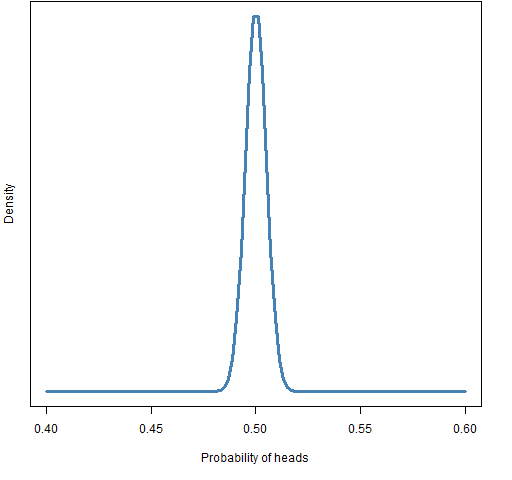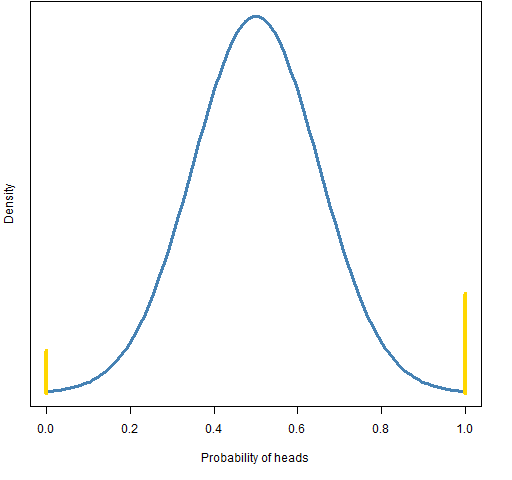An introduction to Bayesian analysis and why you might care.
Fight club
The subject of statistics is about how to learn. Given that it is about the unknown, it shouldn’t be surprising that there are deep differences of opinion on how to go about doing it (in spite of the stereotype that statisticians are accountants minus the personality).
A slightly simplistic division of statistical philosophies is:
- frequentist estimator
- frequentist tester
- Bayesian
We’ll explore that division with the coin in my pocket.
Flip a coin
What’s the probability — sight unseen — that a flip of my coin will be heads?
The frequentist estimator will say that without data there is no way to tell — it could be anything. We’re in complete ignorance.
The frequentist tester will probably hypothesize that the probability is one-half, then say there is no evidence to reject that hypothesis.
A Bayesian will say that the probability has a distribution centered on one-half and is close to it. Something like the distribution in Figure 1.
Figure 1: Bayesian prior distribution for the probability of “heads”. 
A smarter Bayesian will take account of whose pocket the coin is in, and say the distribution is more like that of Figure 2.
Figure 2: Alternative Bayesian prior for “heads”, point masses in gold. 
The coin could be two-headed, could be two-tailed, could be bent.
Figures 1 and 2 are prior distributions — what is thought before seeing any data.
Learning
Now let’s start flipping the coin.
first flip
The first flip is heads. That rules out that the probability is zero.
first 6 flips
The first 6 flips are all heads.
The frequentist estimator estimates that the probability is 1 with confidence intervals that go from 1 down to some value. The 95% confidence interval goes down to 54%.
The frequentist tester may reject the hypothesis that the probability is one-half because the p-value is rather small.
The Bayesians will combine their priors with the data to arrive at a posterior distribution. In this case these will look like the priors but will be shifted (somewhat) towards 1. The posterior after 6 flips is the prior for flip 7.
first 100 flips
There are 53 heads and 47 tails — so still 6 heads ahead.
The frequentist estimator has a point estimate of 53% with a 95% confidence interval that goes from about 43% to 63%.
The frequentist tester will have to unreject the null hypothesis.
R> binom.test(53, 100) Exact binomial test data: 53 and 100 number of successes = 53, number of trials = 100, p-value = 0.6173 alternative hypothesis: true probability of success is not equal to 0.5 95 percent confidence interval: 0.4275815 0.6305948 sample estimates: probability of success 0.53
The posterior for the first Bayesian will look fairly similar to the prior. The posterior for the second Bayesian will look a whole lot like the posterior for the first.
Statisticians in action
As you learned more about the coin in my pocket, you probably went through a process similar to the Bayesians (though you probably allowed the initial 6 heads to have too much impact). The Bayesian way of thinking is more natural to a lot of people.
Yet Bayesian statistical analyses are in the minority. Why? Two reasons:
- computing power
- necessity
Bayesian analyses of more than textbook interest tend to require substantial computing power. It is only recently that the requisite computing power has arrived.
For a lot of analyses, there is no need to be Bayesian. If there is enough data, then the prior distribution makes essentially no difference at all.
Note 1: Frequentists will likely complain at this point that the real reason that frequentist analyses are predominant is because they are more valid. Even conditional on that being true, I don’t think that is the reason for their ascendancy. If frequentist analysis were computer intensive and Bayesian were not, then Bayesian would dominate.
Note 2: I consider myself a pragmatist. I’m not particularly attached to any philosophy.
Fields like physics, agriculture and medicine can operate just fine without resorting to Bayesian statistics. Mainly, at least — there may be cases where Bayes would be useful.
Bayes goes to the bank
Finance is different. While we have lots of numbers, we don’t necessarily have lots of information.
Finance is ripe for Bayesian statistics. We are often in the situation where our prior guesses do have a material effect on results.
But we don’t need to do a formal Bayesian analysis to benefit. The key element of Bayesian statistics is shrinkage.
After 6 coin flips we had all heads. But our Bayesians didn’t believe the probability of heads was 1, that estimate was shrunk (somehow) towards 0.5. (Real Bayesians resist producing estimates, they want to just give you their posterior.)
Here are a couple of examples of using shrinkage.
expected returns
If you have a model that predicts asset returns, it is not going to be perfect. The Efficient Market Model says that the expected return is zero. That model is not correct, but it’s pretty good. You’ll be able to make your predictions better by shrinking them towards zero. We have a prior that the expected returns are close to zero.
predicted variance matrix
Ledoit-Wolf variance estimation starts with the usual variance estimate and then shrinks it towards a simple model. In particular, it shrinks towards all of the correlations being equal. Thus we are using a prior that all the correlations are roughly equal.
R for Bayes
The first stop for learning about Bayesian analyses in R should probably be the Bayesian task view.
Hot off the press is Stan which has an R interface.
See also
Jarrod Wilcox has a piece on Bayesian investing.
You can learn more than you want to know at Wikipedia and Scholarpedia.
Epilogue
Yo ye pharoahs, let us walk
Through this barren desert, in search of truth
And some pointy boots, and maybe a few snack crackers.
from “Camel Walk” by Rick Miller

— Finance is ripe for Bayesian statistics. We are often in the situation where our prior guesses do have a material effect on results.
Which is why we live in a Great Recession: the guesses overwhelmed the data. The financial quants will always deny they’re culpability, of course. Kind of like the patricide who begs mercy of the court for being an orphan.
I’ll not deny that stupid things weren’t (and aren’t) done in quant finance, but I think the major responsibility for the Great Recession lies elsewhere.
Macroeconomics has much more leverage and is a place where data hardly budges priors. On this topic I highly recommend George Cooper’s book The Origin of Financial Crises.
I still haven’t read the book, but my views on the general notion are already with the linked post.
I don’t think Bayesian inference caused the Recession (though I am a frequentist, being a natural skeptic), but you have to admit that the false assumptions about the probability of risks embedded in VAR and variants of Black Scholes had a lot to do with enabling the buildup of massive leverage, which is ultimately what led to the crisis being as severe as it was. When you start assuming you understand processes beyond what the available data says, you’re asking for trouble. Better to live in enlightened ignorance, fully cognizant in the limits of your knowledge and plan accordingly than to invest billions in statistical sandcastles just because your prior doesn’t include big waves.
Tom,
Thanks for your comments.
I agree that VaR was (and almost surely is) used inappropriately. But I think the effect of such deficiencies was rather like adding a liter of kerosine to a forest fire.
The real problem, I think, was the incentives that were (and are) in place. See for instance John Kay’s “The Truth about Markets”. And remember Chuck Prince’s famous “As long as the music is playing, you have to dance.” In such an environment rationality is not going to win.
I think the real failing of quants was failing to speak up when they saw dangerous things. (I include myself in this, by the way.)
An apropos blog post is: http://diffuseprior.wordpress.com/2012/09/04/bmr-bayesian-macroeconometrics-in-r/ on Bayesian macroeconmics in R.
good article!!
well, quants are effected by variable factors be it tech/ budget/ mgmt constraints and what not.. so dnt blame logic (weapon) but the user
So THAT’s why Bayesians moon, eh? Always knew there must be a reason… just didn’t know what it was ’til I saw this bit of info.
For those confused by this comment, there is an older meaning of “to moon” than the usual contemporary meaning. Still, it’s not entirely clear to me which Heather meant.
Pingback: Saturday links: infrastructure neglect | Abnormal Returns
Pingback: Sharpe ratios, replacing managers and random portfolios | Portfolio Probe | Generate random portfolios. Fund management software by Burns Statistics
Pingback: Effective risk management with R | Portfolio Probe | Generate random portfolios. Fund management software by Burns Statistics
Forr the reason that the admin of this website is working, no unceretainty very rapidly it will be well-known, due to its quzlity contents.
Feel fre tto surf to my web-site: triche